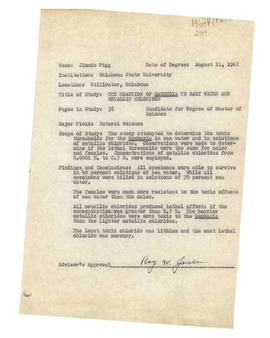| dc.contributor.advisor | Jones, Roy W. | |
| dc.contributor.author | Pigg, Jimmie | |
| dc.date.accessioned | 2016-02-26T15:20:12Z | |
| dc.date.available | 2016-02-26T15:20:12Z | |
| dc.date.issued | 1962-08 | |
| dc.identifier.uri | https://hdl.handle.net/11244/31870 | |
| dc.description.abstract | Scope of Study: The study attempted to determine the toxic thresholds for the Gambusia in sea water and in solutions of metallic chlorides . Observations were made to determine if the lethal thresholds were the same for males and females. Concentrations of metallic chlorides from 0.0001 M. to 0.7 M. were employed. | |
| dc.description.abstract | Findings and Conclusions: All specimens were aloe to survive in 40 percent solutions of sea water. While all specimens were killed in solutions of 70 percent sea water. | |
| dc.description.abstract | The females were much more resistant to the toxic effects of sea water than the males . | |
| dc.description.abstract | All metallic chlorides produced lethal effects it the concentration was greater than 0.7 M. The heavier metallic chlorides were more toxic to the Gambusia than the lighter metallic chlorides. | |
| dc.description.abstract | The least toxic chloride was lithium and the most lethal chloride was mercury. | |
| dc.format | application/pdf | |
| dc.language | en_US | |
| dc.rights | Copyright is held by the author who has granted the Oklahoma State University Library the non-exclusive right to share this material in its institutional repository. Contact Digital Library Services at lib-dls@okstate.edu or 405-744-9161 for the permission policy on the use, reproduction or distribution of this material. | |
| dc.title | Reactions of Gambusia affinis (Girard) to salt water and metallic chlorides | |
| dc.contributor.committeeMember | Bruneau, L. Herbert | |
| osu.filename | Thesis-1962R-P631r.pdf | |
| osu.accesstype | Open Access | |
| dc.type.genre | Master's Report | |
| dc.type.material | Text | |
| thesis.degree.discipline | Natural Science | |
| thesis.degree.grantor | Oklahoma State University | |
